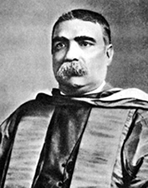Mookerjee, Asutosh
Mookerjee, Asutosh (1864-1924) educationist, Jurist, a judge of the Calcutta High Court and vice-chancellor of the Calcutta University. Born on 29th June 1864 in Bhawanipur, Calcutta to Gangaprasad Mookerjee, a famous doctor of his time and Jagattarini Devi, he passed the Entrance Examination from Calcutta University in 1879. Asutosh graduated from the presidency college in 1884 and did his MA in 1885 in Mathematics and the next year in Physics. He was awarded Eshan Scholarship in 1884 and obtained premchand roychand studentship (PRS) in 1886. He was a specialist in geometry.

Two of his outstanding academic contributions were Geometry of Conics published in 1893 and Law of Perpetuities published in 1898. He founded the Calcutta Mathematical Society in 1908. He became Doctor of Law in 1894 and Tagore Law Professor in 1898. In 1904 he became a judge of the Calcutta High Court.
Prior to this, Asutosh had become a Fellow of the Calcutta University and a member of its Syndicate in 1889. He was a member of the Council of the Lieutenant Governor of Bengal from 1899 to 1903 as a representative of the calcutta university. Lord curzon appointed him a member of the University Commission in 1902. In 1906 he became the vice-chancellor of the Calcutta University and this office he held till 1914.
Almost throughout the whole period of his vice-chancellorship Bengal witnessed the anti-partition and swadeshi movement at its height. The nationalists criticized that Calcutta University controlled colonial education only and lacked human resource developing and nation-building orientation. It was, according to Satish Chandra Mukherjee, over literary, all-too-academic, unscientific and unindustrial and only produced clerks for the Raj. The movement for National Education started with Satish Chandra Mukherjee founding the Bhagavat Chatuspathi in 1895. It mainly dealt with cultural heritage of India and was transformed into the dawn society in 1902, which served as a model for a national university between 1902 and 1906.
The education provided by the Calcutta University missed national objective. The scope of national education was further curtailed by the universities Act of 1904 by which government-nominated European members controlled the Senate and the Syndicate of the Calcutta University. Their aim was to prevent any nationalist ideology from entering into the administration and curriculum of Calcutta University. They also tried to disaffiliate many private colleges established by Swadexi intellectuals under the Calcutta University.
The government found in Asutosh Mookerjee the person it was looking for. Asutosh was not in favour of a national university to counteract the activities of Calcutta University. According to him, Calcutta University had set up an academic tradition, which should be preserved, and western education imparted by it should also be utilised in national interest. He was in favour of reform and not a revolution in Calcutta University. The government felt that Calcutta University would be safe under his care and would not become a political battleground.
Asutosh Mookerjee implemented most of the nationalist agenda within the framework of the university. He set up new departments in arts and sciences in the two campuses at College Street and Rajabazar and opened the departments of Vernacular Language and Ancient Indian History. Many eminent educationists, both foreign and Indian, were appointed as Professors of various departments. He personally supervised the framing of syllabus of all departments, presided over their Boards of studies. Concerned with student welfare, he pursued their interest in both teaching and examination.
Asutosh Mookerjee was the vice-chancellor for a second term between 1921 and 1923. During this time he became the president of the two PG Councils of arts and sciences. He was also the most influential member of the Senate and the Syndicate since 1889. He was indeed the moving spirit of the university. He successfully combined at the Calcutta University the benefits of Western and national education, without being involved in politics. He thus caused a renaissance at the Calcutta University. It served a national purpose no less than the national university founded by the National Council of Education though the nationalist spirit was more manifest in the latter. In engineering and technology the national university had greater achievements. Calcutta University still had a colonial hangover and Asutosh had not been able to change its character totally.
Asutosh retired from the Calcutta High Court and the Calcutta University in 1923 and died at Patna on 25 May 1924. [Chittabrata Palit]
